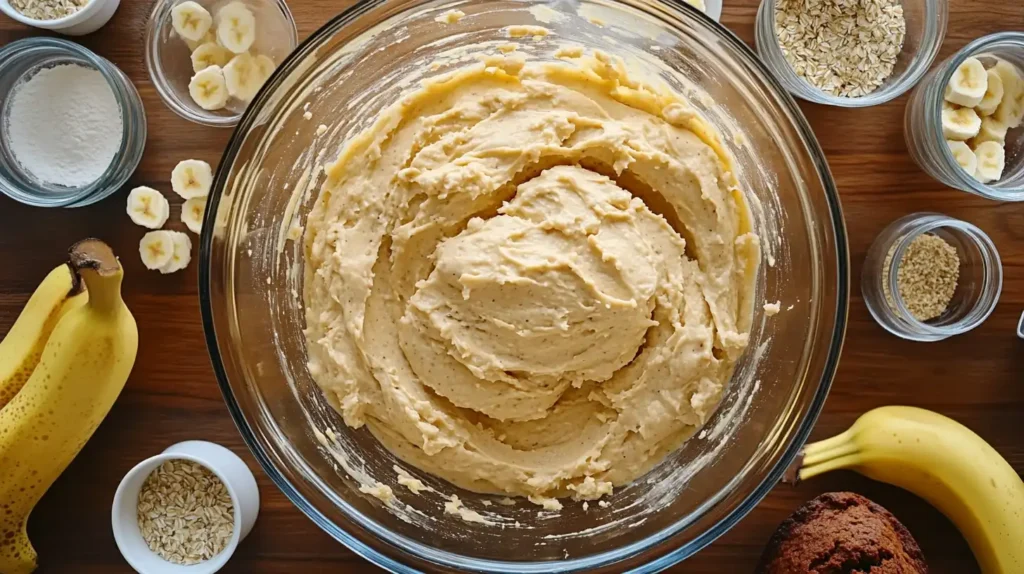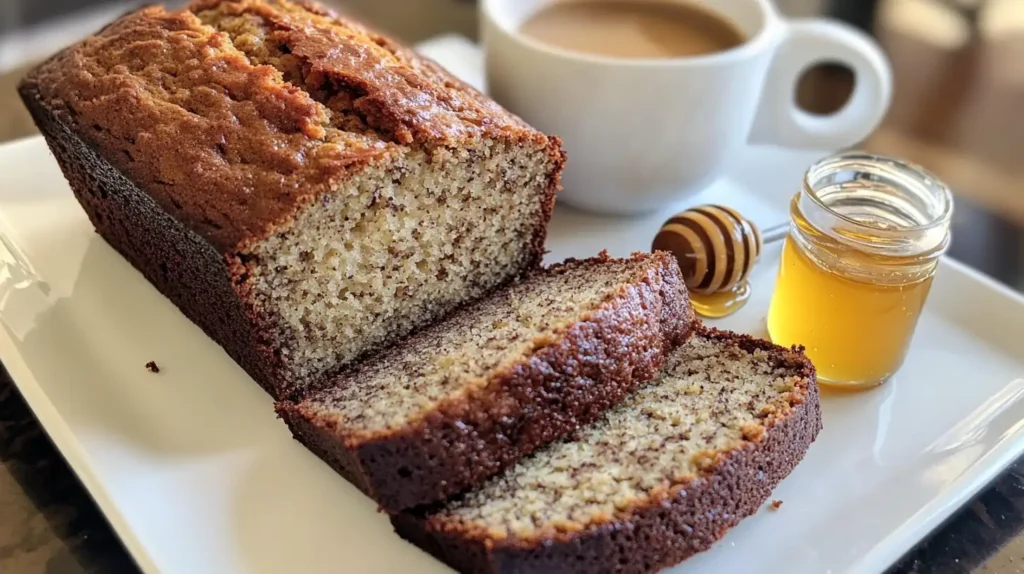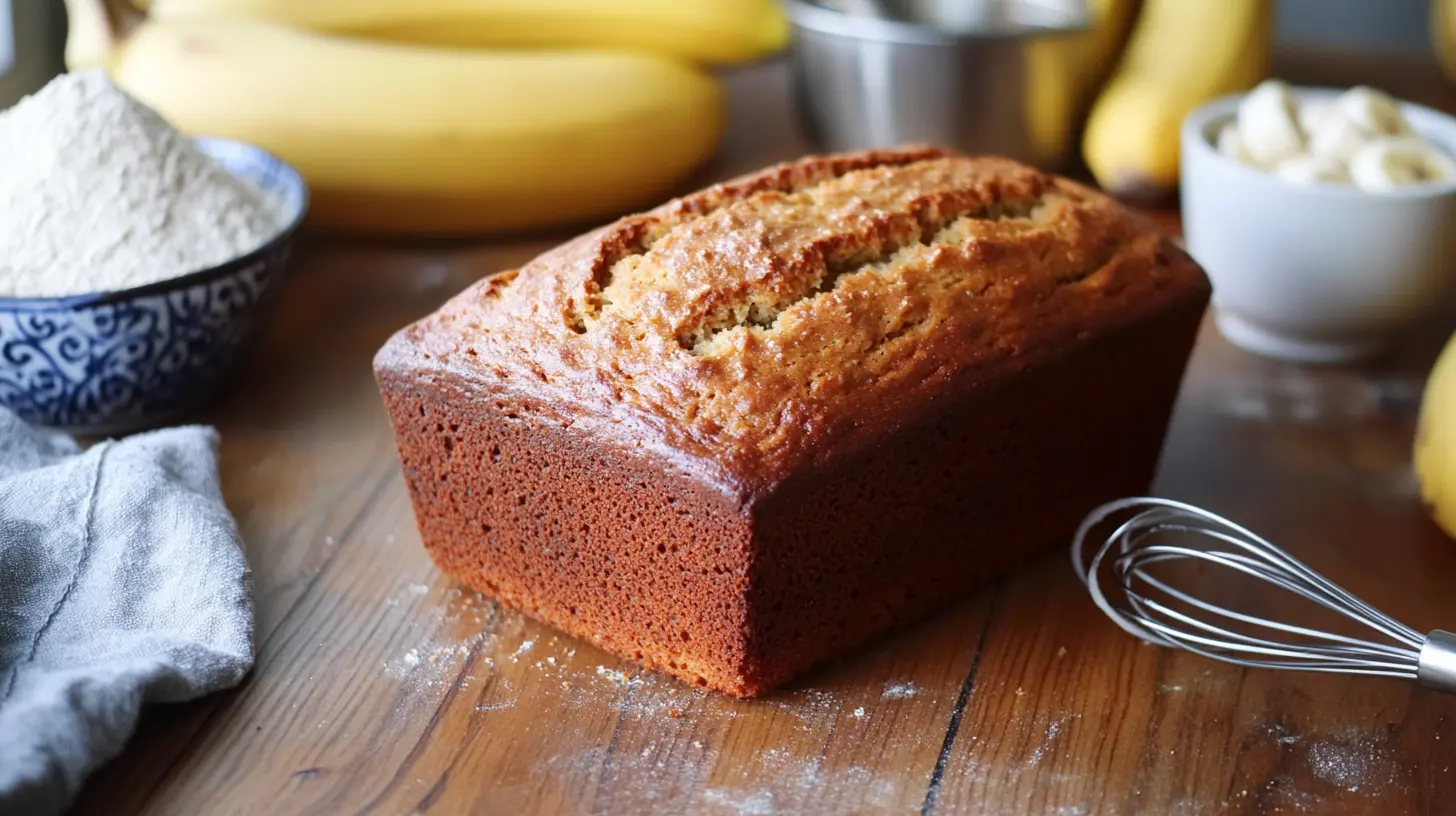How to Make Gluten-Free Banana Bread has never been easier or more enjoyable. This guide covers everything you need to bake the perfect loaf, including tips on choosing the best ingredients, troubleshooting common issues, and creating exciting variations. Whether you’re gluten-sensitive, following a specific diet, or simply love a good banana bread, this recipe will be your new favorite.
Table of Contents
Understanding Gluten-Free Baking
What Does Gluten-Free Mean?
Gluten-free baking eliminates gluten, a protein found in wheat, barley, and rye, which gives traditional baked goods their structure and elasticity. For individuals with celiac disease, gluten intolerance, or those simply avoiding gluten for health reasons, it’s crucial to use alternative flours and ingredients that mimic gluten’s properties.
Benefits of Gluten-Free Diets for Baking Enthusiasts
Gluten-free diets can reduce inflammation, improve digestion, and cater to specific dietary needs. Plus, gluten-free baking opens up a world of creative possibilities with unique flours like almond, coconut, and oat, which add distinct flavors and textures.
Challenges of Gluten-Free Baking
Despite its perks, gluten-free baking comes with hurdles. Without gluten’s binding power, baked goods can turn out crumbly or dry. That’s where xanthan gum or guar gum comes in, acting as a stabilizer. Additionally, gluten-free batters require precise measurements and often need a mix of flours to achieve the desired texture.
Ingredients for Gluten-Free Banana Bread
Creating delicious gluten-free banana bread starts with selecting the right ingredients. Let’s explore what makes this treat both tasty and gluten-free!
Choosing the Right Gluten-Free Flour
The key to achieving the perfect texture lies in the gluten-free flour blend. Opt for all-purpose blends that include a mix of rice flour, potato starch, and tapioca flour for a balance of structure and softness. Brands like Bob’s Red Mill and King Arthur offer reliable options. Adding xanthan gum or guar gum ensures your bread holds together beautifully.
Sweeteners and Their Role in Banana Bread
While granulated sugar is classic, other sweeteners like coconut sugar or maple syrup bring a deeper flavor to the mix. For a healthier twist, honey or agave syrup can work wonders without overpowering the natural sweetness of the bananas.
The Importance of Ripe Bananas
Using overripe bananas is a game-changer. Their high sugar content enhances the flavor while their moisture keeps the bread tender. Look for bananas with plenty of brown spots—they’re perfect for this recipe.
Optional Add-Ins for Extra Flavor
Get creative with mix-ins! Add chocolate chips for indulgence, chopped nuts for crunch, or even dried fruits like cranberries for a tangy surprise. These ingredients not only elevate the flavor but also make the bread more versatile.
For additional insights on gluten-free baking, check out tonsrecipes.com/gluten-free-thanksgiving for tips and variations.
Step-by-Step Instructions for Making Gluten-Free Banana Bread

Preparation: Tools and Equipment Needed
Gather your essentials: a loaf pan, mixing bowls, a whisk, and a rubber spatula. Don’t forget to preheat your oven to 350°F (175°C) and grease your pan with butter or non-stick spray to avoid sticking.
Mixing Wet Ingredients: Tips for Consistency
Mash the ripe bananas until smooth, then combine them with eggs, oil (or melted butter), vanilla extract, and your chosen sweetener. Whisking the wet ingredients thoroughly ensures even mixing and a light texture.
Combining Dry and Wet Ingredients: Avoiding Overmixing
In a separate bowl, whisk together your gluten-free flour, baking powder, baking soda, salt, and optional spices like cinnamon. Slowly fold the dry ingredients into the wet mixture using a spatula. Be gentle to avoid overmixing, which can make the bread dense.
Baking Techniques for Even Cooking
Pour the batter into your prepared loaf pan, smoothing the top. Bake in the center of the oven for 50–60 minutes. To check doneness, insert a toothpick—it should come out clean or with a few moist crumbs.
Testing for Doneness: Tricks to Get It Right
If your loaf browns too quickly, tent it with foil during the last 15 minutes of baking. Let the bread cool in the pan for 10 minutes before transferring it to a wire rack. This prevents it from breaking apart.
Tips for Perfect Gluten-Free Banana Bread
Mastering the art of gluten-free baking can be tricky, but with these expert tips, your banana bread will come out perfect every time.
Adjusting for Different Altitudes
Baking at higher altitudes can affect how your banana bread rises. To compensate, slightly reduce the baking soda or powder by 1/4 teaspoon and increase the liquid by a tablespoon. These small adjustments ensure the bread maintains a soft and fluffy texture.
Storing and Reheating Your Banana Bread
To keep your banana bread fresh, store it in an airtight container at room temperature for up to three days. For longer storage, wrap it in plastic wrap and freeze it for up to three months. When you’re ready to enjoy it again, thaw the bread overnight and warm slices in the oven or toaster for that fresh-baked feel.
Troubleshooting Common Issues
If your bread turns out too dry, double-check your measurements—too much flour can soak up moisture. A dense loaf may mean the batter was overmixed, while a flat bread could indicate expired baking powder or soda. Making these corrections will elevate your baking game.
For more helpful tips, explore tonsrecipes.com/gluten-free-thanksgiving for inspiration on gluten-free recipes.
Variations of Gluten-Free Banana Bread
One of the best things about banana bread is its versatility. Here are some creative twists on the classic gluten-free recipe to suit every taste.
Adding Chocolate Chips or Nuts
For a decadent touch, fold in dark chocolate chips or chunks. If you’re craving crunch, chopped walnuts, pecans, or almonds pair perfectly with the sweet banana flavor. These additions enhance both taste and texture.
Making It Vegan: Egg Substitutes
Going vegan? Replace the eggs with flaxseed or chia seed gel (1 tablespoon of seeds mixed with 3 tablespoons of water per egg). You can also use mashed avocado or applesauce for a similar binding effect. This variation ensures everyone can enjoy your gluten-free banana bread.
Low-Sugar or Keto-Friendly Variations
To reduce sugar, swap granulated sugar for natural sweeteners like erythritol, stevia, or monk fruit. For keto-friendly bread, use almond flour and increase the eggs for added moisture.
For more creative gluten-free recipes, consider exploring our site or trying recipes like tonsrecipes.com/high-protein-gluten-free-snacks.
Serving Suggestions and Pairings
Once you’ve mastered how to make gluten-free banana bread, the fun part begins—serving it! Here are some ideas to make every slice more delightful.

Pairing with Spreads: Butter, Jam, or Nut Butter
Enjoy your banana bread warm with a generous slather of butter for classic simplicity. For a sweet and fruity touch, spread on a layer of your favorite jam or preserves. If you’re looking for a protein-packed option, almond butter, peanut butter, or hazelnut spread offers a rich and satisfying pairing.
Creative Presentation Ideas
Turn your banana bread into an impressive dessert by topping it with a dollop of whipped cream or a scoop of vanilla ice cream. For special occasions, drizzle a glaze made from powdered sugar and lemon juice over the loaf. These simple additions can make even an everyday treat feel like a celebration.
Whether you’re enjoying your bread as breakfast, a snack, or dessert, these serving ideas add extra flair and flavor to your gluten-free creation.
FAQs
To wrap things up, here are answers to some common questions about how to make gluten-free banana bread.
Why is My Gluten-Free Banana Bread Dense?
A dense loaf often means the batter was overmixed or lacked enough leavening. Be gentle when folding your ingredients, and ensure your baking powder or soda is fresh.
Can I Use Almond Flour Instead of Gluten-Free Flour?
Yes, but almond flour behaves differently than standard gluten-free blends. It’s heavier, so you may need to increase eggs and reduce other liquids to get the right consistency.
What Is the Shelf Life of Gluten-Free Banana Bread?
Stored in an airtight container, your bread will stay fresh for 2–3 days at room temperature. For extended storage, freeze it for up to three months.
Can I Freeze Gluten-Free Banana Bread?
Absolutely! Slice your bread first, then wrap each slice in plastic wrap before storing it in a freezer-safe bag. Thaw individual slices for quick snacks or breakfasts.
These tips and answers ensure you’ll succeed every time you bake. Ready to get started? How to make gluten-free banana bread has never been easier!
Exploring Health Benefits of Gluten-Free Banana Bread
When learning how to make gluten-free banana bread, it’s natural to wonder about its health benefits. This delightful treat not only caters to gluten-sensitive individuals but also offers surprising nutritional perks.
Nutritional Benefits
Gluten-free banana bread is often made with nutrient-rich ingredients like almond or oat flour, which provide healthy fats and fiber. Bananas, the star ingredient, are packed with potassium, vitamin B6, and antioxidants, making every slice as nourishing as it is tasty.
Suitable for Various Diets
This bread is a fantastic choice for people with celiac disease, gluten intolerance, or those following a gluten-free lifestyle. By using natural sweeteners or sugar substitutes, it can also fit low-sugar and keto diets, ensuring everyone at the table can enjoy it.
A Balanced Indulgence
While it’s still a treat, making gluten-free banana bread at home lets you control the ingredients. Add-ins like nuts and seeds can boost protein content, while reducing sugar makes it a healthier option than store-bought alternatives.
By incorporating wholesome ingredients, this bread becomes a guilt-free indulgence perfect for breakfast or a midday snack.
Common Mistakes and How to Avoid Them
Even the best bakers encounter hiccups when mastering how to make gluten-free banana bread. Let’s tackle some common mistakes to ensure your baking journey is smooth and successful.
Overmixing the Batter
Mixing the batter too vigorously can activate the starches in gluten-free flour, resulting in a dense and gummy texture. To avoid this, gently fold your wet and dry ingredients until just combined.
Skipping Ripe Bananas
Under-ripe bananas lack the natural sweetness and moisture essential for perfect banana bread. Always use bananas with brown spots—they’re soft, sweet, and perfect for baking.
Incorrect Measurements
Precision matters in gluten-free baking. Too much flour can make the bread dry, while too little can make it fall apart. Always use measuring cups or a kitchen scale for accuracy.
Forgetting to Test for Doneness
Gluten-free banana bread often needs a few extra minutes to bake compared to traditional recipes. Test with a toothpick in the center of the loaf—it should come out clean or with a few crumbs.
By addressing these mistakes, you’ll be set to bake the best gluten-free banana bread every time.
Conclusion
Mastering how to make gluten-free banana bread is both rewarding and fun. With the right ingredients, thoughtful preparation, and a little creativity, you can whip up a loaf that’s moist, flavorful, and perfect for any occasion. Whether you stick to the classic recipe or try a variation, this guide ensures success every time. Happy baking!

